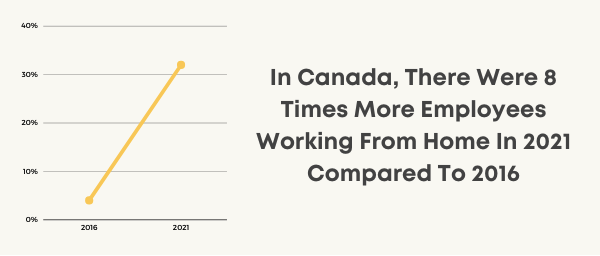Once the COVID-19 pandemic was announced in 2020, Canada went into lockdown with the rest of the world.
Social distancing rules meant that many workers had to leave their offices and go home to work remotely.
Are Canadian workers more or less productive when working from home? How many would prefer to stay working remotely even when the pandemic is over?
The answers to those and other remote work statistics for Canada can be found in the article below. Get reading!
11 Remote Work Statistics For Canada
1. At the start of 2021, 32% of Canadian workers (aged 15 to 69) were working from home most of the time, compared to 4% in 2016.
According to remote work statistics Canada, the percentage of the workforce who worked remotely jumped by 28% between 2016 and 2021.
Source: Statistics Canada


2. From February 2021, due to COVID, 3.1 million Canadian workers had to temporarily work remotely.
One year into the pandemic, a large number of Canadian workers were still working from home although temporarily.
Source: Statistics Canada
3. 90% of new teleworkers were just as productive working from home, as they were on-site.
While nine in 10 reported they are just as productive at home as they are in the office, some of them also were more productive. For instance, roughly one in three (32%) reported that they get more work done in the same hours at home than they do on-site. Ten percent said they accomplish less, while 58% accomplish just as much as they do on-site.
Source: Statistics Canada
4. 48% of those who get more work done per hour and 44% of those who get less work done per hour also reported working longer hours per day while working from home.
Only 3% of teleworkers reported working shorter hours at home than they did on-site. While the large majority does longer hours per day since working from home, this could affect their work-life balance and even lead to remote working burnout.
Source: Statistics Canada
5. About 20% of those who reported being less productive say it is so due to the lack of interactions with colleagues.
Among other reasons as to why those who work from home are less productive, caring for children and other family members is reported by almost 20%. Information about work and devices (11%) and problems with Internet speed (5%) are also some of the reasons remote workers reported for being less productive. These distractions can influence how they work from home.
Source: Statistics Canada
6. 80% of new teleworkers want to continue working from home at least to some extent after the pandemic.
Out of that 80%, 41% would like to work half of the hours at home and the other half away from home. Moreover, 24% would prefer working most of their hours at home. Likewise, 15% would like to work from home full-time. Also, 11% want to spend most of their hours working from home, and 9% full-time hours away from home. Women could work 28% of hours at home, and men 22% of hours.
Source: Statistics Canada


7. Around 5 million Canadians were working from home in March 2021.
The number of five million Canadian workers accounts for around 20% of their workforce, which means that 80% were not working remotely.
Source: Statista
8. 14% of Canadian workers combine on-site and remote work.
In terms of hybrid work models, 14% of the Canadian workforce is combining work in the workplace (such as an office) with work from locations outside of the workplace (working from home).
Source: Statistics Canada
9. Up to 25% of the Canadian workforce will stay working remotely after the pandemic.
Out of those who stay working home after the pandemic, 44% are university-educated people. On the other hand, 9% are workers with no post-secondary education.
Source: Statistics Canada
10. Employees in Ontario and Quebec have a greater preference for remote work.
Thirty-six percent of Ontario’s employees say their ideal workplace is primarily or entirely remote, compared to 34% nationwide. An even bigger number is in Quebec, where 40% say their ideal workplace is remote.
Source: PwC
11. Canadian workers’ biggest challenge since working remotely due to the pandemic is work-life balance (47%).
While workers struggle a lot with setting a boundary between work and life, 46% of them also struggle with staying productive while working from home.
Source: PwC
Final Verdict
To sum up, remote work in Canada is a growing trend, seeing an 8-time increase over the period of 5 years. This is mostly due to the pandemic that sent so many to work from home. These remote work statistics Canada show us that even in the future, workers want to continue working remotely, if not full-time than at least to some extent. Moreover, this also means that remote work hiring will be on the rise in the future.

































Find Us on Socials